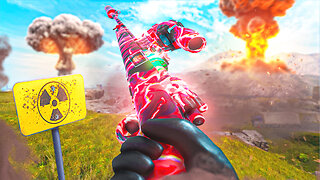Premium Only Content

Serious moment, a look inside grow, Canada.This is me I have a auto immune disorder
I suffer from unclosing spontaneous.I suffer from an autoimmune disorder. Known as degenerative osteoarthritis of the facet joints, which is the medical term for ANKYLOSING SPONDYLITIS:
Ankylosing spondylitis is an inflammatory disease that, over time, can cause some of the bones in the spine (vertebrae) to fuse. This fusing makes the spine less flexible and can result in a hunched posture. If ribs are affected, it can be difficult to breathe deeply.
Ankylosing spondylitis affects men more often than women. Signs and symptoms typically begin in early adulthood. Inflammation can also occur in other parts of the body — most commonly, the eyes.
Men are more likely to develop ankylosing spondylitis than are women. Onset generally occurs in late adolescence or early adulthood. Most people who have ankylosing spondylitis have the HLA-B27 gene. But many people who have this gene never develop ankylosing spondylitis.
Causes :
Ankylosing spondylitis has no known specific cause, though genetic factors seem to be involved. In particular, people who have a gene called HLA-B27 are at a greatly increased risk of developing ankylosing spondylitis. However, only some people with the gene develop the condition.
Symptoms :
Early signs and symptoms of ankylosing spondylitis might include pain and stiffness in the lower back and hips, especially in the morning and after periods of inactivity. Neck pain and fatigue also are common. Over time, symptoms might worsen, improve or stop at irregular intervals.
The areas most commonly affected are:
The joint between the base of the spine and the pelvis
The vertebrae in the lower back
The places where tendons and ligaments attach to bones, mainly in the spine, but sometimes along the back of the heel
The cartilage between the breastbone and the ribs
The hip and shoulder joints
Mechanism of Ankylosing Spondylitis :
Ankylosing means ‘joining together’ and spondylitis means ‘inflammation in the vertebrae’ (the bones that make up the spine). In ankylosing spondylitis, there appears inflammation in the joints of the spine and sacroiliac joint (SI Joint, between the sacral spine and pelvis) and fusion of these joints in the long run.
In the case of ankylosing spondylitis, T cells begin the inflammation in SI joint and joints of the spine. With time, these joints start eroding and get damaged. The sacroiliac joints are located in the low back where the sacrum (the bone directly above the tailbone) meets the iliac bones (bones on either side of the upper buttocks). In a person suffering from AS, joints and ligaments that generally allow the spine to move, get inflamed and stiffen up. This inflammation takes place where the ligaments or tendons are attached to the bones.
In the process of healing, new bone develops at the site of damage, replacing flexible cartilage and bridging the gap between two bones. As a result, the elastic tissue is replaced by bony growth. Continued formation of new bone can lead to fusion of the vertebrae (bones of the spine), leading to a significant reduction in the movement of the spine.
The spine is the central support structure of the body. It keeps us upright. Although there are many bones (vertebra) in the spine (stacked one over the other) it is flexible due to the presence of elastic intervertebral spinal discs and ligaments. An intervertebral disc is a fibrocartilaginous cushion between two vertebrae. Each disc has an annulus fibrosus (tough exterior of a spinal disc) and has nucleus pulposus (soft inner core). In ankylosing spondylitis, annulus fibrosus become calcified and fuse with adjacent vertebrae. Continued formation of new bone can lead to fusion of the vertebrae, leading to a considerable reduction in the movement of the spine. Ankylosing Spondylitis can also affect eyes, lungs, bowel, and heart.
Complications :
In severe ankylosing spondylitis, new bone forms as part of the body's attempt to heal. This new bone gradually bridges the gap between vertebrae and eventually fuses sections of vertebrae. Those parts of the spine become stiff and inflexible. Fusion can also stiffen the rib cage, restricting lung capacity and function.
Other complications might include:
• Eye inflammation (uveitis) - One of the most common complications of ankylosing spondylitis, uveitis can cause rapid-onset eye pain, sensitivity to light and blurred vision. See your doctor right away if you develop these symptoms.
• Compression fractures - Some people's bones weaken during the early stages of ankylosing spondylitis. Weakened vertebrae can crumple, increasing the severity of a stooped posture. Vertebral fractures can put pressure on and possibly injure the spinal cord and the nerves that pass through the spine.
.
-
 LIVE
LIVE
Amish Zaku
5 hours agoA Celebration of Ozzy Osbourne's Life, Music, and Spirit
265 watching -
 48:41
48:41
The Mel K Show
6 hours agoMel K & Aaron Day | Wake up! Walking Blindly into Totalitarian Technocracy | 7-22-25
44.6K14 -
 1:05:20
1:05:20
BonginoReport
8 hours agoEpstein: From “Case Closed” to “To Be Continued” - Nightly Scroll w/ Hayley Caronia (Ep.95)
143K76 -
 1:40:54
1:40:54
Anthony Rogers
1 day agoEpisode 375 - Randy Valerio
10.8K2 -
 1:32:14
1:32:14
Kim Iversen
8 hours ago"Obama Belongs In Jail!" Tulsi Gabbard Exposes Entire Russiagate Hoax
117K134 -
 LIVE
LIVE
AlphaZeroOmega
4 hours ago $0.35 earnedHitman: ⚔ Ozzy Osbourne Tribute ⚔ | 🚨Rumble Studio Direct RTMP🚨
44 watching -
 2:16:28
2:16:28
Robert Gouveia
8 hours agoBarrack Obama is GUILTY!! Declassified Docs RELEASED! Ghislaine Maxwell MEETING!!
58.5K26 -
![[LIVE] (Mid-Stream Break) Kirby and The Forgotten Land | First Playthrough | 4 | Forbidden No Longer/Forgotten No More](https://1a-1791.com/video/fww1/fe/s8/1/M/2/H/4/M2H4y.0kob-small-LIVE-Kirby-and-The-Forgotte.jpg) LIVE
LIVE
Joke65
3 hours ago[LIVE] (Mid-Stream Break) Kirby and The Forgotten Land | First Playthrough | 4 | Forbidden No Longer/Forgotten No More
5 watching -
 3:01:37
3:01:37
GritsGG
4 hours agoWin Streaking! Most Wins 3100+! 🔥
1.71K -
 3:28:53
3:28:53
charwinslow
5 hours ago🐈 Pokemon: Violet IRL Team Nintendo Switch 2 playthrough!
14.8K